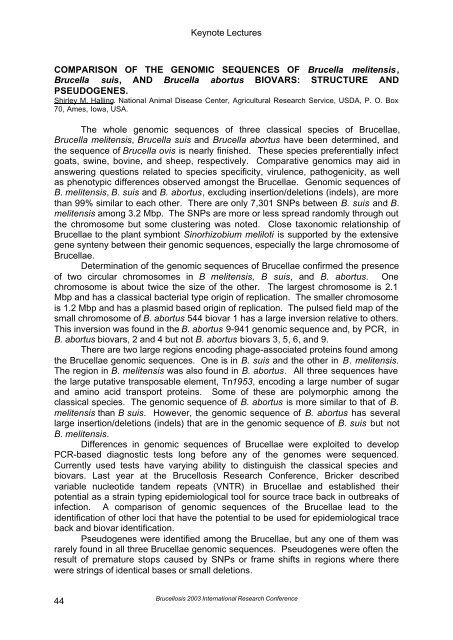Brucellosis 2003 proceedings - PHIDIAS
Brucellosis 2003 proceedings - PHIDIAS
Brucellosis 2003 proceedings - PHIDIAS
Create successful ePaper yourself
Turn your PDF publications into a flip-book with our unique Google optimized e-Paper software.
Keynote Lectures<br />
COMPARISON OF THE GENOMIC SEQUENCES OF Brucella melitensis,<br />
Brucella suis, AND Brucella abortus BIOVARS: STRUCTURE AND<br />
PSEUDOGENES.<br />
Shirley M. Halling. National Animal Disease Center, Agricultural Research Service, USDA, P. O. Box<br />
70, Ames, Iowa, USA.<br />
The whole genomic sequences of three classical species of Brucellae,<br />
Brucella melitensis, Brucella suis and Brucella abortus have been determined, and<br />
the sequence of Brucella ovis is nearly finished. These species preferentially infect<br />
goats, swine, bovine, and sheep, respectively. Comparative genomics may aid in<br />
answering questions related to species specificity, virulence, pathogenicity, as well<br />
as phenotypic differences observed amongst the Brucellae. Genomic sequences of<br />
B. melitensis, B. suis and B. abortus, excluding insertion/deletions (indels), are more<br />
than 99% similar to each other. There are only 7,301 SNPs between B. suis and B.<br />
melitensis among 3.2 Mbp. The SNPs are more or less spread randomly through out<br />
the chromosome but some clustering was noted. Close taxonomic relationship of<br />
Brucellae to the plant symbiont Sinorhizobium meliloti is supported by the extensive<br />
gene synteny between their genomic sequences, especially the large chromosome of<br />
Brucellae.<br />
Determination of the genomic sequences of Brucellae confirmed the presence<br />
of two circular chromosomes in B melitensis, B suis, and B. abortus. One<br />
chromosome is about twice the size of the other. The largest chromosome is 2.1<br />
Mbp and has a classical bacterial type origin of replication. The smaller chromosome<br />
is 1.2 Mbp and has a plasmid based origin of replication. The pulsed field map of the<br />
small chromosome of B. abortus 544 biovar 1 has a large inversion relative to others.<br />
This inversion was found in the B. abortus 9-941 genomic sequence and, by PCR, in<br />
B. abortus biovars, 2 and 4 but not B. abortus biovars 3, 5, 6, and 9.<br />
There are two large regions encoding phage-associated proteins found among<br />
the Brucellae genomic sequences. One is in B. suis and the other in B. melitensis.<br />
The region in B. melitensis was also found in B. abortus. All three sequences have<br />
the large putative transposable element, Tn1953, encoding a large number of sugar<br />
and amino acid transport proteins. Some of these are polymorphic among the<br />
classical species. The genomic sequence of B. abortus is more similar to that of B.<br />
melitensis than B suis. However, the genomic sequence of B. abortus has several<br />
large insertion/deletions (indels) that are in the genomic sequence of B. suis but not<br />
B. melitensis.<br />
Differences in genomic sequences of Brucellae were exploited to develop<br />
PCR-based diagnostic tests long before any of the genomes were sequenced.<br />
Currently used tests have varying ability to distinguish the classical species and<br />
biovars. Last year at the <strong>Brucellosis</strong> Research Conference, Bricker described<br />
variable nucleotide tandem repeats (VNTR) in Brucellae and established their<br />
potential as a strain typing epidemiological tool for source trace back in outbreaks of<br />
infection. A comparison of genomic sequences of the Brucellae lead to the<br />
identification of other loci that have the potential to be used for epidemiological trace<br />
back and biovar identification.<br />
Pseudogenes were identified among the Brucellae, but any one of them was<br />
rarely found in all three Brucellae genomic sequences. Pseudogenes were often the<br />
result of premature stops caused by SNPs or frame shifts in regions where there<br />
were strings of identical bases or small deletions.<br />
44<br />
<strong>Brucellosis</strong> <strong>2003</strong> International Research Conference
















